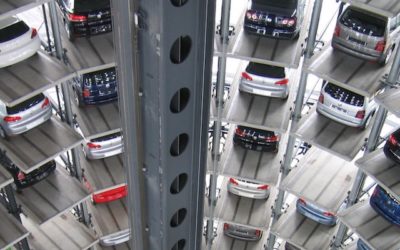Adding AVs versus taking away people’s cars:
What we are likely to see in the coming years…
Proponents of autonomous vehicle technologies almost always start with one key reason for their value: safety. The most common statistics that come out are on how many thousands of people die every year in car crashes, and how over 90% of these are the fault of human error. The solution, they imply, is to develop and deploy autonomous vehicles (AVs) that let computers do the driving.
The problem with this line of thinking is that adding AVs to our roadways will do nothing to improve safety, nor will it improve traffic congestion, pollution, or turn parking lots into parks. All of those things are actually talking about something different: removing today’s human-driven cars from the road.
Sure, if fully driverless taxis or buses become cheaper than those that employ humans, it could certainly mean that their old driver-operated counterparts would be replaced (likely, sold to a second life in places without AV technology). But for a variety of reasons, no matter how quickly we can offer fully driverless cars, it will be a long time before a majority of today’s drivers willingly give up their vehicles.
Cars: A Love Affair
Car ownership has been sold to North Americans in particular through the past century as a form of romance and freedom. The open road through the country, the control of acceleration and maneuvering through turns – cars have long become part of the American dream of independence, wealth, and personal pleasure.
Of course, driving isn’t always like this. In city traffic or in hazardous weather that romance and freedom can disappear. It is in these instances that many people long for a break from the unpleasant work of driving, and indeed would welcome the chance to use a driverless car. (Though, unfortunately, these are the hardest driving scenarios for computers to reliably manage.) But so long as any shred of romance or freedom remains, our positive associations to our vehicles will keep many of us clutching our steering wheels if anyone tries to pry them away from us. In many instances, people still like driving.
On top of this, a large part of our economy today is based on individuals driving their own vehicles, and the majority of people aren’t particularly interested in upending their own jobs, no matter how many new city parks they are offered in exchange. Whole industries are tied to our ownership and use of cars, from car manufacturers, dealers, and mechanics, to the industries of road construction, insurance, and, morbidly, the economy of lawyers, doctors, police, and emergency responders. Cities bring in a large part of their revenue from traffic and parking fines. Ending human driving, or even car ownership, would create significant economic problems for many people today. So don’t be surprised if they don’t support the idea.
A More Realistic Future
So, instead of a new utopia of driverless cars replacing all others, what we are more likely to see in coming years is the incremental addition of a few AVs in certain situations. Shuttle buses that operate on specific routes, perhaps separated from other traffic in their own closed lanes. Driverless taxis that supplement driver-operated fleets in good conditions in limited areas. Of course, a lot of people won’t be interested in these vehicles, because although they will be safe, they will also be slow. But depending on the economics involved, they could potentially be cheaper.
At the same time, more and more automated features will work their way into our human-driven cars. People will continue to drive themselves, perhaps with the option of putting the car on autopilot for certain parts of their trip. But the number of human-driven cars on North American roads will not significantly decrease (despite a portion of urbanites opting for car-sharing over ownership).
Even when the technology allows it, smart cities will ban zero-occupancy trips for private vehicles. Letting people send their cars through town empty will only make our problems with pollution and congestion much worse. Delivery or sanitation vehicles could become autonomous, but without other infrastructure changes they will likely still need humans to load and unload them. The same goes for trucking, which could certainly be made safer and more efficient from increased automation, but will doubtlessly still employ people for some parts of their operation until complete new systems for the docking and transfer of goods is established.
Solving Problems
So although a world of driverless cars could indeed solve many of our current problems with road safety, pollution, congestion, and urban design, our affection for driving, owning, and relying on automobiles for our mobility and our economy is not likely to allow them to do so anytime soon. But regardless of how soon AV technology changes our current habits, there are other ways we can address these same issues as well. If we want to reduce pollution (and dependence on fossil fuels), we can focus on switching to electric cars. If we want to reduce car ownership and parking, we can focus on car-sharing. But shared or electric cars need not be autonomous, just as driverless cars need not be electric nor shared.
In order to reach our goals, however, we will need to make clear choices as communities about our transportation priorities. When are cars offering us romance and freedom, and when are they not? When are they helping us, and when are they creating problems? If we want walkable neighborhoods, clean air, pedestrian safety, and public spaces and parks, we must decide to make them a priority. Conversely, if we want private, comfortable lives spent in our own bubbles staring at screens, that’s clearly an option as well. With AV technology quickly on its way, the choice of how we put it to use is ours.
Although it’s likely that many people will continue to drive as long as they can buy cars and fuel, together as communities we can decide which roads we want to provide for people to do so. If we build highways into the hearts of our cities, we will make use of them as drivers. If we replace parking lots with parks or close streets and turn them into pedestrian malls, as drivers we will adapt. In fact, if we provide good alternatives such as special lanes for cheap autonomous buses or other options of quality mass-transportation, many of us will even opt to save our driving for the open roads.
That is, until we get bored – and click on the autopilot.
More Articles on Automated Vehicles:
The Surprising Downside to Driving
The car is the perfect transportation device. It takes me anywhere, anytime I want, effortlessly and fast…
read moreAVs might not be the biggest change coming to city transportation
AVs are being hailed as the solution to our transportation problems. But the biggest wins may lie elsewhere.
read moreWe can do a lot without AVs
AVs are coming… but we don’t have to wait
read more



